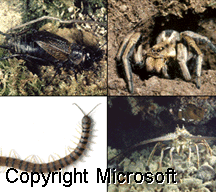
| |
 |
![]()
 From the Survival:Bug site.
From the Survival:Bug site.
Bugs can be crushed and added to stews. This disguises the appearance and reduces the spew factor. Bees and wasps are OK eaten after a good boiling. The poison is basically a protein which disassembles at boiling temperatures. The stinger softens. Pounding them before boiling is effective. Bee and Wasp larvae are delicious! Many insects are edible (grubs, grasshoppers, ants, slugs, maggots, and earthworms to name a few).
Avoid insects which carry disease, are poisonous, have fine hairs, bright colors, or eight or more legs. One of the most dangerous insects is in the cantharidin family (blister beetles). I doubt that you will run into those unless you pop over to the Mediterranean just to munch bug. There are of course many cautions. ... Just a note. Beetles amount to about 40% of the known insects. The larvae of many beetles are very high in fat and protein and make great snacks.
- When in doubt about a bug do the insect safety test. And follow these time tested rules.
- Always try to cook insects.
Never eat bugs you find dead.
Don't eat bugs that bite back!
If it smells really bad, don't eat it!One last thought ... If you have a strong stomach, or at least a clear spew zone for a technicolor yawn ... try maggots. Road kills are often infested with them. Gather a handfull or two, drop your prize into an old sock and rinse in cold clear water a couple of times, then boil. After about five minutes toss in a bullion cube. When it is finished dissolving, settle back to a fine hot stew of what looks like brown rice. It is really a fine meal.